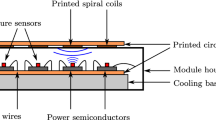Abstract
High speed interconnections between chips and on top of chips in form of microstriplines constructed on the basis of high temperature superconductors and on the basis of copper are compared at 80° K for the case of step-like impulses in the frequency region of 0.1 GHz to 10 GHz,i.e., under conditions related to VHSI. High temperature superconductors are more favourable in regard to the minimum possible width of the stripline. Copper is more favourable in regard to the available area of the wiring board because of a lower possible value of the relative dielectric constant of the isolator between the conducting strips. Formulae for the minimum possible widthw of the stripline and for the maximum numbern of striplines within one layer of the wiring board are given—the wiring board considered has maximum size only just fulfilling the condition that all signals should reach their destination within half the clock time. By means of these formulae numerical values are evaluated on the basis of the properties of existing high temperature superconductors, copper and appropriate dielectric materials.
Similar content being viewed by others
References
R. C. Frye, MRS 1987 Fall Meeting, Nov. 30-Dec. 5, Symp. I, paper 1.1.4.
O. K. Kwon, B. W. Langley, R. F. W. Pease and M. R. Beasley, IEEE Electron Device Lett. 8, 582 (1987).
F. Lange, Thin Solid Films, July 88 (in the press).
P. Vielhauer and F. Donath, Nachrichtentechnik-Elektronik31, 103 (1981).
F. Donath and P. Vielhauer, Nachrichtentechnik-Elektronik30, 270 (1980).
V. L. Newhouse, Applied Superconductivity, John Wiley & Sons, New York-London-Sidney, 1964, p. 216.
R. L. Kautz, J. Appl. Phys.,49, 308 (1978).
T. Y. Hsiang, J. F. Whitaker, R. Sobolewski, D. R. Dykaar and G. A. Mourou, Appl. Phys. Lett.51, 1551 (1987).
S. Sridhar, J. Appl. Phys. 63, 159 (1988).
J. Tateno and N. Masaki, Jpn. J. Appl. Phys.26, L1564 (1987).
A. Umezawa, G. W. Crabtree, J. Z. Liu, T. J. Moran, S. K. Malik, L. H. Nunez, W. L. Kwok and C. H. Sowers, Phys. Rev. Lett. Nov. 87.
E. A. Lynton, Superconductivity, Methuen & Co., London, 1962.
M. Hein, N. Klein, G. Müller, H. Piel and R. W. Roth, Workshop on S.C., Argonne 87.
J. F. Kwak, E. L. Venturini, D. S. Ginsley and W. Fu, Novel Superconductivity, Plenum Publishing Corporation, 1987 (edited by S. A. Wolf and V. L. Kresin).
Author information
Authors and Affiliations
Rights and permissions
About this article
Cite this article
Lange, F. Comparison of superconducting and normal conducting high speed interconnections at 80 K. J. Electron. Mater. 18, 251–257 (1989). https://doi.org/10.1007/BF02657416
Received:
Revised:
Issue Date:
DOI: https://doi.org/10.1007/BF02657416




